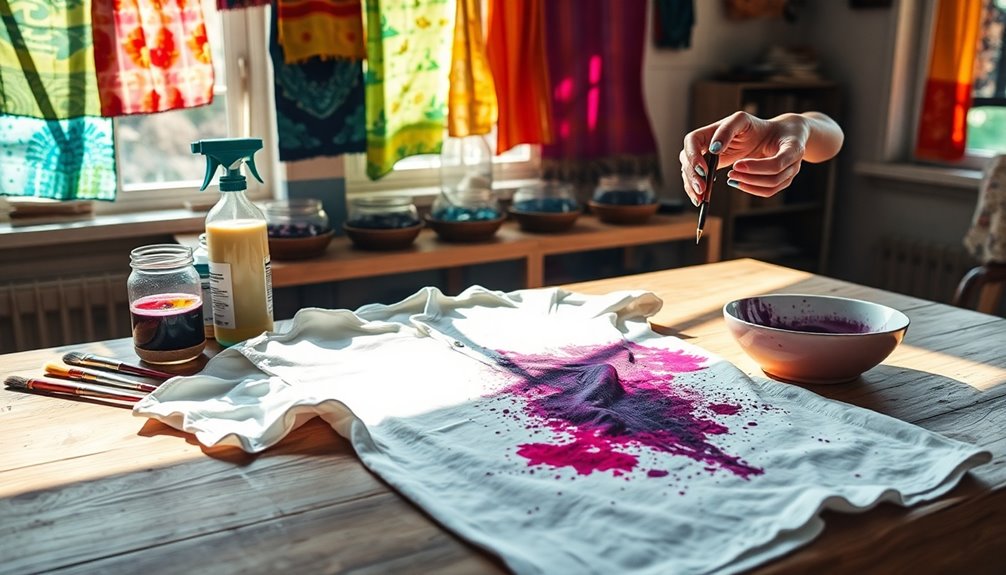Bleach stains might feel like the end for your clothes, but you can salvage them with a few easy DIY fixes. First, rinse the affected area with cold water for 5-10 minutes to minimize damage. For small stains on darker fabrics, gently rub the edges with a cotton ball soaked in rubbing alcohol. If the stain is larger, try a mixture of white vinegar and water. You can also revive your garment by applying fabric dye that matches the original color. These solutions could transform your stained item into something special, and there's plenty more to explore!
Understanding Bleach Stains
When you accidentally bleach your clothes, it's important to understand how bleach stains occur. Unlike traditional stains, bleach stains result from the chemical properties of bleach stripping color from the fabric, leading to lighter patches. The severity of these bleach stains can vary based on the fabric composition. Natural fibers like cotton absorb bleach more readily, while synthetic fibers tend to resist its effects. In fact, choosing fabrics made from sustainable materials can help reduce the likelihood of such damage in the first place. Additionally, opting for eco-friendly fashion brands can minimize the risk of bleach stains by providing alternatives that are less susceptible to damage.
Immediate rinsing with cold water is vital once a bleach accident happens. This step helps remove excess bleach, preventing further fabric weakening or discoloration.
Unfortunately, bleach stains are permanent and can't be removed in the conventional sense. Instead, the focus shifts to the restoration of color, where you explore options for fixing the appearance of your clothing. Choosing eco-friendly sustainable packaging solutions can also help minimize waste when replacing damaged items.
Understanding the fabric composition of your garments is essential in this process. Different materials react uniquely to bleach, which can influence the methods you use for treatment and restoration. Knowing what your clothes are made of will guide you in making the best choices to salvage them after an unfortunate bleach mishap.
Immediate Actions to Take
When you notice a bleach stain, act fast to minimize the damage.
Start by rinsing the affected area with cold water to remove any excess bleach.
Next, whip up a baking soda paste to neutralize the stain and protect your fabric. Additionally, you can explore using expense management apps that streamline financial organization to help manage any costs associated with clothing repairs or replacements. This can be particularly useful for freelancers who often need to track expenses related to tax filing and material costs. Utilizing tools like budgeting apps can help ensure you have the funds available for such unexpected expenses.
Rinse With Cold Water
Bleach stains can be frustrating, but quick action can make a difference. The first step you should take is to rinse with cold water immediately. This not only helps remove excess bleach but also prevents further fabric damage. Cold water is more effective at neutralizing the bleach's active ingredients than warm or hot water, reducing the risk of discoloration spreading.
Here's what you need to do:
- Locate the stain: Identify the affected area on your fabric.
- Rinse under running water: Hold the stained section under cold running water for at least 5-10 minutes. This guarantees thorough removal of the bleach.
- Avoid scrubbing: Resist the urge to scrub the fabric, as this can damage the fibers further.
Prompt action is critical; the sooner you rinse the area, the better your chances of minimizing the stain's severity.
Neutralize With Baking Soda
After rinsing the stained area, it's important to neutralize any remaining bleach to prevent further damage to your fabric. To do this, create a neutralizing paste by mixing three parts baking soda with one part water. This simple mixture can effectively neutralize the bleach.
Next, apply it to the bleach stain and let it sit for a while. The baking soda will help counteract the bleach, reducing any potential weakening of the fabric.
Once the paste has dried completely, gently brush it off to eliminate any residual bleach. This step is significant, as it guarantees that all bleach is removed from the fabric.
After brushing, rinse the fabric thoroughly with cold water to confirm no baking soda or bleach remains. This final rinse is crucial to prevent further fabric weakening, keeping your garment in good condition.
If the stain persists or if your fabric is delicate, it's wise to consult a laundry specialist. They can provide tailored solutions to help salvage your clothes effectively.
Taking these immediate actions can help you restore your garment and minimize damage from bleach stains.
Rubbing Alcohol Method
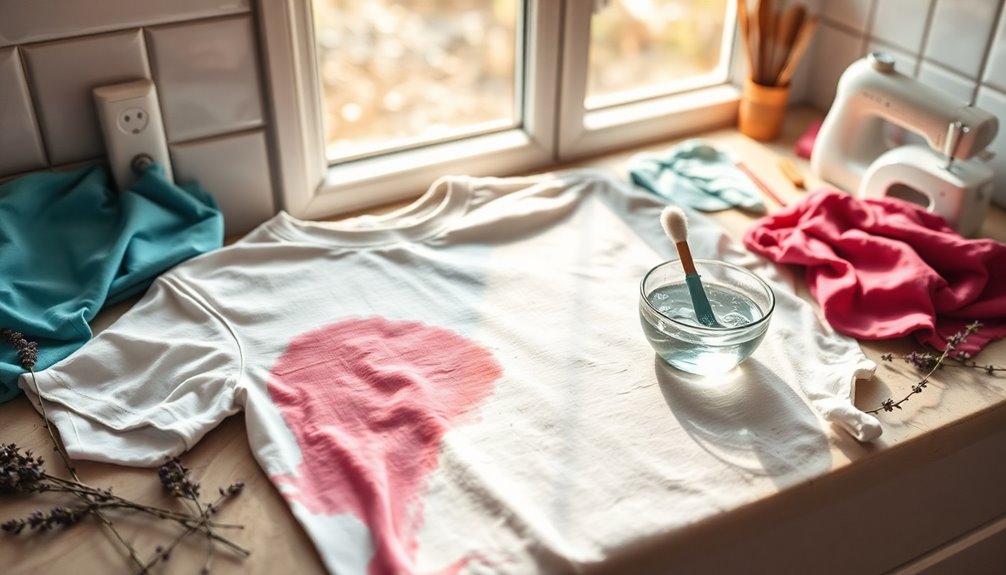
The rubbing alcohol method offers a practical solution for small bleach stains on dark fabrics. This technique works by loosening excess dye, allowing the original color to spread back into the fabric and restore its appearance. Additionally, this method contributes to promoting sustainable consumption patterns by extending the life of your clothing. This approach is similar to how budgeting principles guide individuals to make informed financial decisions.
Here's how to effectively use this method:
- Test First: Always test the rubbing alcohol on an inconspicuous area of the fabric to verify it won't cause any additional damage or discoloration.
- Apply Rubbing Alcohol: Soak a cotton ball in rubbing alcohol and gently rub around the small bleach stains. Start from the edges and move toward the center, which helps prevent further spreading of the stain.
- Rinse the Area: After treatment, rinse the area thoroughly with cold water to remove any residual alcohol. This step is essential to avoid further fabric damage.
Using this method can be a quick fix for minor touch-ups, saving your favorite dark fabrics from looking worn out. Additionally, this approach mirrors the concept of expense tracking, which allows you to monitor spending habits effectively.
However, remember to stay patient and careful, as proper application will yield the best results.
Fabric Dye Application
Sometimes, fabric dye application can be a great way to breathe new life into a garment that's fallen victim to bleach stains. To achieve the finest results, choose a fabric dye that closely matches the original color of your garment. This will help blend the new color with the existing fabric. Additionally, maintaining a balance between savings and investments is essential for overall financial health, allowing for future clothing repairs.
Before you start, consider using a color remover to eliminate any residual dye, guaranteeing an even application. Additionally, using automated investment management tools can help you save money for future clothing repairs.
When you're ready to dye, wear old clothes and gloves to protect your skin and avoid staining any other garments. It's vital to follow the instructions on the dye package carefully, as they outline preparation, application, and setting times for peak results.
Before applying the dye to the entire garment, always test the dye on an inconspicuous area first. This step assures compatibility and helps you avoid unintended discoloration. Regularly reviewing your spending habits can also enhance your ability to manage costs effectively.
If the test area looks good, you can go ahead and dye your garment. With a little patience and attention to detail, you can restore your favorite pieces and make them wearable again! Additionally, using expense tracking tools can help you manage the costs associated with maintaining your wardrobe effectively.
Lemon Juice for White Clothes
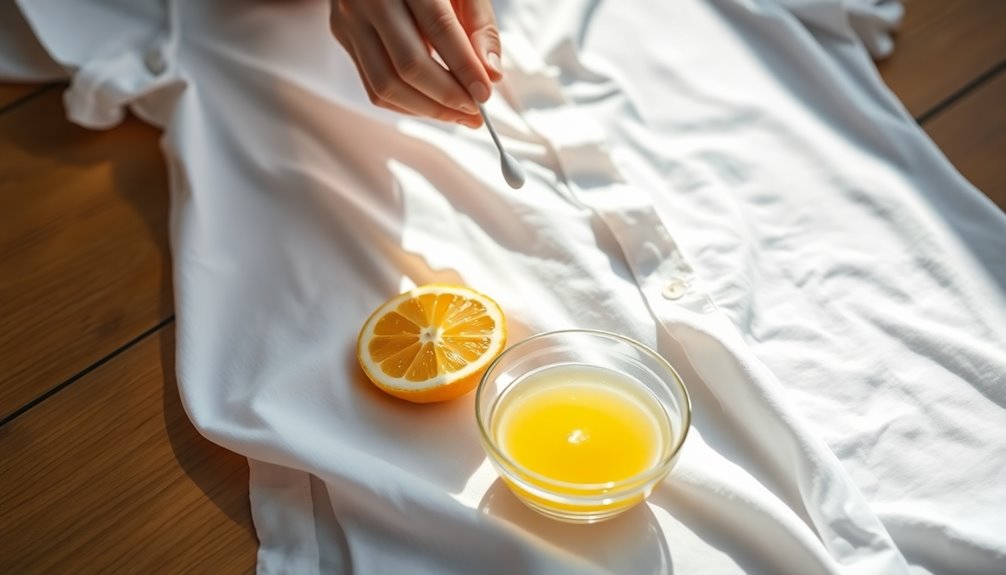
Lemon juice can be an effective, natural solution for tackling bleach stains on white clothes. Its acidity acts as a mild bleaching agent, helping to restore whiteness while also offering antibacterial properties for cleaning. Additionally, using digital coupons can make purchasing cleaning supplies more affordable, allowing you to keep your cleaning arsenal well-stocked. Budget apps can also assist in tracking your spending on cleaning supplies, ensuring you stay within your financial limits.
Here's how you can use lemon juice to treat those pesky bleach stains:
- For larger stains: Soak the affected area in a mixture of lemon juice and hot water for about 30 minutes. The citric acid will penetrate the fabric, working to lighten the stain effectively.
- For smaller stains: Apply lemon juice directly to the stain and let it sit for about 10 minutes. This concentrated treatment can help lighten the area without needing a lengthy soak.
- Rinse thoroughly: After treatment, make sure to rinse your white clothes with cold water. This step is essential to remove any remaining lemon juice, preventing further discoloration. Additionally, maintaining financial organization can enhance your ability to manage cleaning supplies effectively, ensuring you always have what you need on hand.
Baking Soda Paste Technique
If lemon juice doesn't quite do the trick for your bleach stains, the baking soda paste technique offers a dependable alternative.
To begin, mix three parts baking soda with one part water until you achieve a thick consistency. Once your paste is ready, apply it generously to the bleach-stained area. Allow the paste to dry completely; this drying process helps absorb and neutralize any residual bleach.
After the paste has dried, gently brush it off the fabric. This step is essential as it removes any lingering bleach particles, minimizing the risk of further fabric damage.
Once you've brushed off the paste, it's time to thoroughly rinse the treated area with cold water. This guarantees that all baking soda and bleach residue is completely washed out, safeguarding your fabric from additional harm.
This method is particularly effective on various fabric types, making it a versatile option for tackling bleach stains.
Treatment for Dark Fabrics
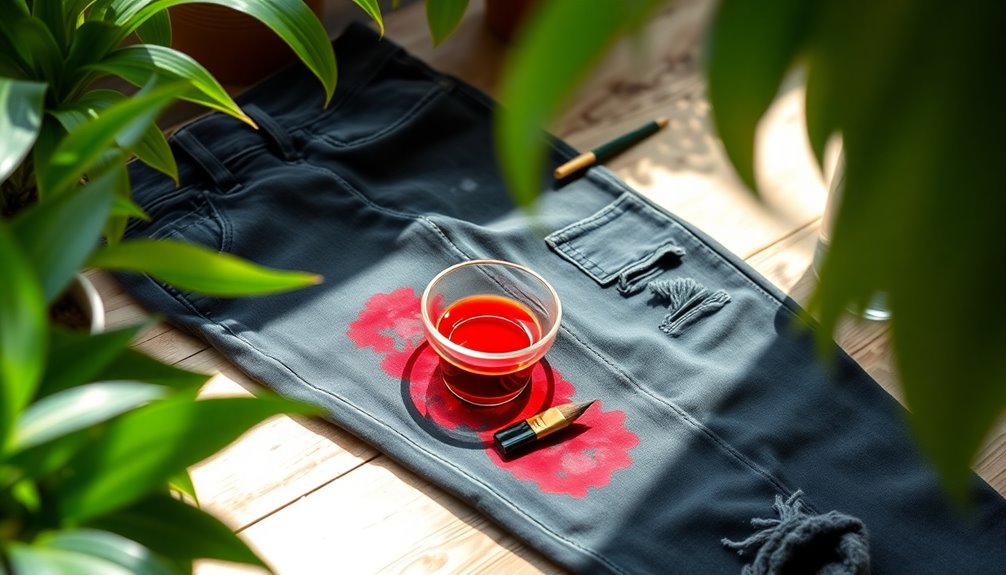
When dealing with bleach stains on dark fabrics, quick action is key to restoring your garment's original appearance.
Start by evaluating the size of the stain. For small spots, take a cotton swab and apply rubbing alcohol. Gently rub the stain from the outside toward the center to help restore the original color by loosening excess dye.
If the stain persists or is larger, consider these steps:
- Mix white vinegar with water and apply it gently to the stained area. This can aid in fading the bleach mark, but remember to rinse thoroughly afterward.
- For more extensive damage, using a fabric dye that closely matches your garment's original color can effectively recolor the affected area. Always test this on an inconspicuous part first to verify it won't damage the fabric.
- For minor touch-ups, Sharpie Rub-a-Dub laundry pens are a great option. They allow you to color in small bleach spots quickly without the hassle of extensive dyeing.
Creative Cover-Up Ideas
When you're faced with bleach stains, it's time to get creative with cover-ups.
You can explore fabric dye techniques to transform the entire garment or use iron-on patches for a quick fix that shows off your style.
If you're feeling adventurous, try some tie-dye solutions to turn those blemishes into unique designs.
Fabric Dye Techniques
Wondering how to transform a bleach stain into a fashion statement? Using fabric dye techniques can turn your mishap into a unique piece of art. To guarantee the best results, follow these simple steps:
- Choose the Right Dye: Select a fabric dye that closely matches the original color of your garment. This helps achieve a seamless restoration.
- Prepare the Fabric: Before dyeing, use a color remover to eliminate the original dye. This step guarantees that the new dye adheres properly and provides an even finish.
- Dyeing Process: Always wear old clothes and protective gloves to avoid staining your skin. Follow the dye manufacturer's instructions carefully, paying attention to water temperatures and setting times for the best outcome.
For a more creative approach, consider using tie-dye techniques or fabric markers to cover the bleach stain. This allows for a personalized touch, transforming the area into a unique design.
With these fabric dye techniques, you'll not only salvage your clothes but also showcase your creativity!
Iron-On Patches
Iron-on patches are a fantastic way to creatively cover up bleach stains on your clothes. Not only do they enhance the garment's appearance, but they also add a personal touch. Available in various designs and colors, you can easily find a patch that fits your style and strategically place it over the stain for a fashionable repair.
Before you start, make sure the fabric is clean and dry. Follow the manufacturer's instructions for the best adhesion results. To adhere the patch, simply position it over the bleach stain, cover it with a cloth, and apply a hot iron for the recommended time. This process securely bonds the patch to the fabric, ensuring a lasting repair.
Using iron-on patches not only conceals damage but also extends the life of your clothing by preventing further fraying or deterioration around the stain.
Creative Tie-Dye Solutions
Transforming a bleach-stained garment into a vibrant masterpiece is easier than you might think. Using creative tie-dye techniques can cleverly conceal those bleach stains, turning damaged areas into unique designs. Here's how to get started:
- Prepare Your Materials: Gather rubber stamps or squeeze bottles filled with diluted bleach. You'll also need cardboard to place between fabric layers to prevent unwanted seepage.
- Create Your Design: Apply the bleach to your fabric using your chosen method, experimenting with different folding techniques and color combinations. This is your chance to personalize the garment and make it truly yours!
- Neutralize Remaining Bleach: After your design is complete, soak the fabric in a hydrogen peroxide solution. This step is essential to neutralize any remaining bleach, preserving the integrity of your masterpiece.
Preventing Future Bleach Stains
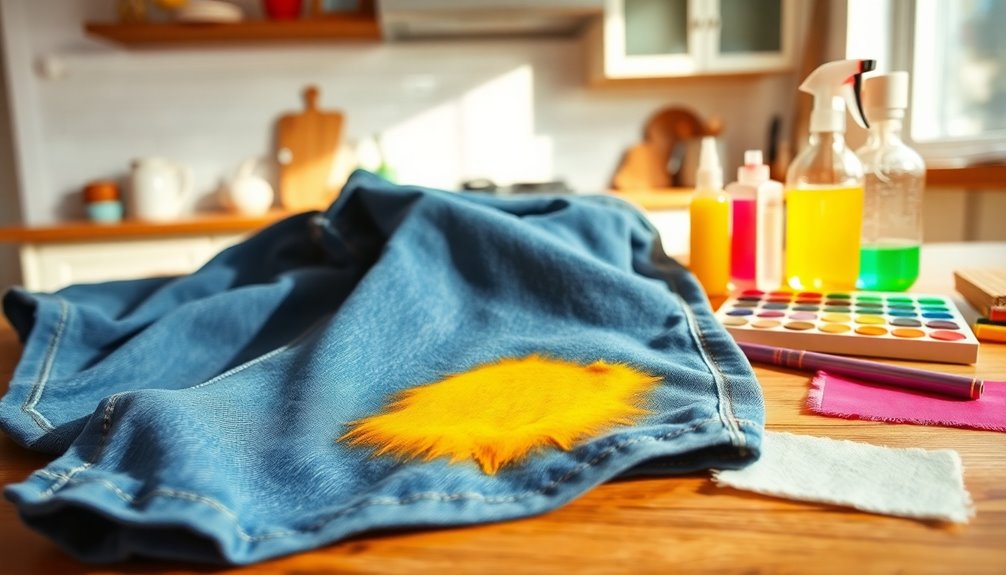
To prevent future bleach stains, it's essential to handle bleach with care and follow a few simple guidelines.
First, always dilute bleach with water before using it. Applying bleach directly to fabric greatly increases the risk of creating visible stains.
Next, be sure to check care labels on your clothing; only use bleach on items marked as bleach-safe. Avoid using bleach on colored or dark fabrics to prevent discoloration.
Additionally, store bleach products securely away from your laundry area. This minimizes accidental spills and exposure to fabrics, which can lead to unwanted stains.
Educating all household members about proper bleach usage and safety protocols is also important. Make sure everyone understands the significance of handling bleach carefully to reduce the chances of mishaps and staining.
When necessary, opt for color-safe bleach alternatives, as they're specifically designed to reduce the risk of damage to colored fabrics.
Finally, avoid brushing fabrics that have come into contact with bleach, as this can further spread the stain and cause more damage.
Safe Use of Bleach
When using bleach, it's crucial to prioritize safety and follow the manufacturer's guidelines to prevent accidents. Understanding how to safely handle bleach cleaning products can save your clothes and protect your health. Here are a few key practices to keep in mind:
- Read Labels: Always check the product information to understand safe use of bleach and dilution requirements before application.
- Dilute Properly: Dilute bleach with water according to recommended ratios. This minimizes the risk of damaging fabrics and makes sure you don't apply it directly to clothing.
- Wear Protection: Use rubber gloves and protective eyewear when handling bleach to prevent skin irritation and protect your eyes from splashes.
Additionally, consider using color-safe bleach alternatives when washing colored fabrics. This reduces the chances of bleach stains and protects your clothing during laundry.
It's also a good idea to educate all household members about proper bleach usage and safety precautions to minimize accidents.
Professional Repair Options
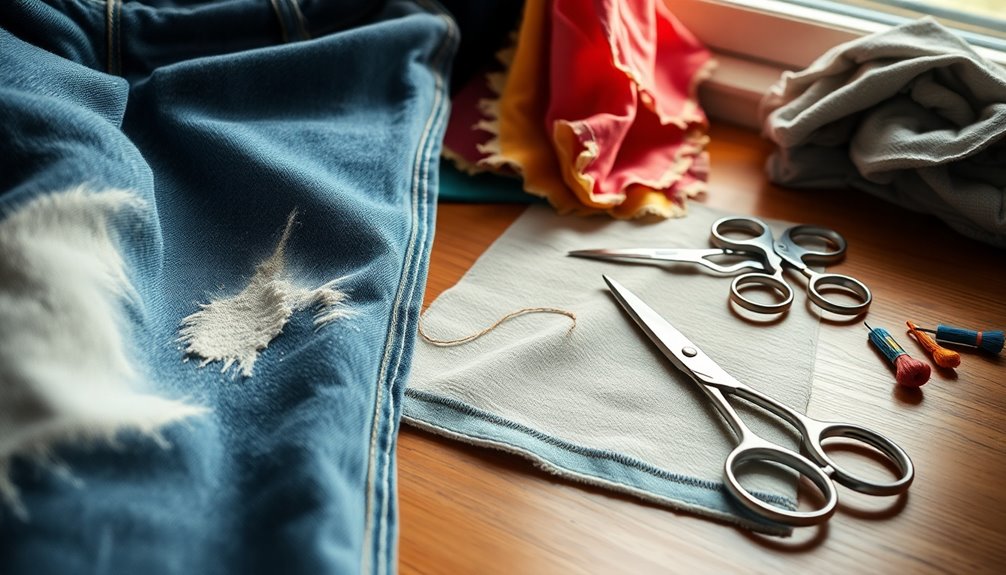
After addressing the safe use of bleach, you might find yourself facing the aftermath of an unfortunate stain. Don't panic! There are professional repair options available that can help salvage your garments.
Professional cleaning services often use specialized techniques and products designed to restore fabric integrity and color, especially for delicate or high-value items.
If the bleach stain is significant, consider consulting with fabric specialists. They can provide tailored advice on the best treatment options for your specific materials, ensuring you get the best results in stain recovery.
Local dry cleaners frequently offer stain removal and repair services, making it convenient to seek expert assistance when needed.
For garments that mightn't be recoverable through traditional methods, tailoring services can effectively patch or re-dye affected areas, providing a more permanent solution.
Additionally, if you're feeling creative, look into professional garment restoration services that focus on upcycling. They can help transform stained items into unique bags or crafts, giving your cherished pieces a new life.
Alternative Stain Removal Methods
Bleach stains can be frustrating, but there are several alternative methods you can try to restore your clothes. Whether you're dealing with white or colored fabrics, you can often remove the stain or at least make it less noticeable.
Here are three effective methods:
- Using Vinegar: For colored clothes, mix equal parts of vinegar and water. Gently blot the bleach stain with a clean cloth soaked in this solution. This can help fade the stain considerably.
- Rubbing Alcohol: If your stain is on dark fabrics, use rubbing alcohol. Dab it around the stain with a cotton swab, carefully working from the outside in. This method can help restore the original color.
- Store-Bought Bleach Removers: Look for products containing sodium thiosulfate. These can be effective in treating bleach stains, but make sure to test them on an inconspicuous area first to avoid further damage.
If all else fails, consider upcycling your damaged garments into new items like bags or crafts, giving them a second life while creatively addressing those pesky bleach stains.
Assessing Fabric Types
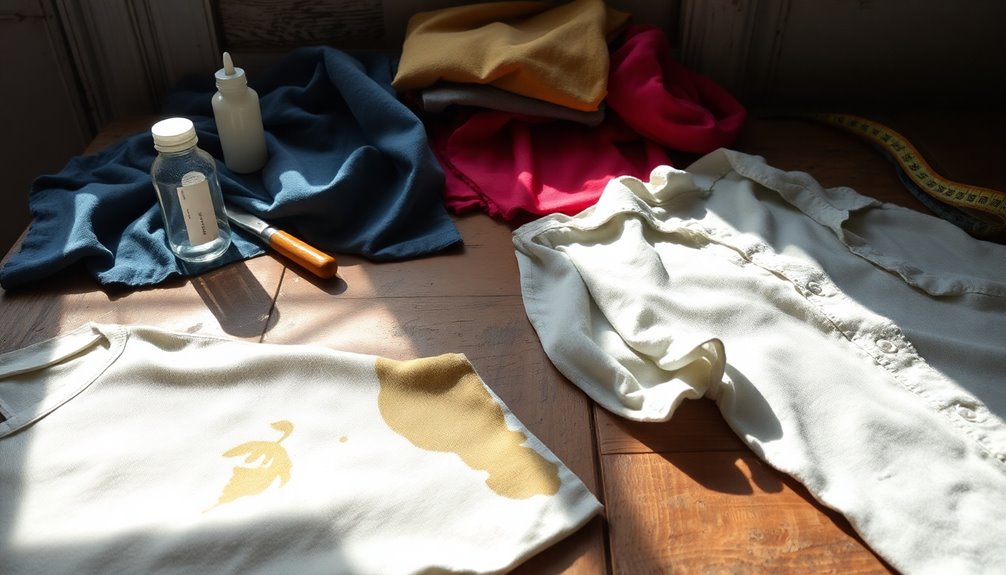
When you're dealing with a bleach stain, it's crucial to know whether your fabric is natural or synthetic.
Each type reacts differently, so understanding your fabric can help you choose the right treatment method.
Always check the care label for specific instructions to avoid further damage.
Natural vs. Synthetic Fibers
Understanding the differences between natural and synthetic fibers is essential for effective stain salvage. Natural fibers, like cotton and linen, absorb bleach more readily, leading to quicker and more noticeable discoloration.
In contrast, synthetic fibers such as polyester and nylon resist bleach stains but can still sustain damage from exposure.
Here are three key points to evaluate regarding fabric composition:
- Reaction to Bleach: Natural fibers strip color quickly due to their chemical structure, resulting in lighter patches. Synthetic fibers may endure the bleach better but can weaken and lose integrity over time.
- Variable Responses: Different natural fibers react uniquely; for instance, silk may weaken and lose its sheen, while wool might felt or become damaged.
- Restoration Techniques: Understanding the specific composition helps you choose the right methods to restore color and integrity. Tailoring your approach based on whether the fabric is natural or synthetic can make a significant difference in salvage efforts.
Fabric Care Labels Importance
Fabric care labels play an essential role in helping you assess the type of fabric and how it may react to bleach and other cleaning agents.
These labels provide important information about material composition, so you can determine whether your garment is made of natural fibers like cotton or synthetic fibers like polyester. Understanding these distinctions is significant since different fabrics respond differently to bleach stains.
When you familiarize yourself with the symbols and terms on fabric care labels, you empower yourself to make informed decisions regarding garment care.
For instance, some labels may warn against using bleach on colored or delicate fabrics. Ignoring these warnings can lead to irreversible damage, making it important to read labels carefully.
Additionally, fabric care labels guide you on proper washing techniques, including temperature settings and whether bleach can be safely used.
By knowing how your fabric type interacts with cleaning agents, you can reduce the risk of accidental bleach stains and extend the life of your clothing.
Expert Tips for Stain Removal
Dealing with bleach stains can feel overwhelming, but with the right expert tips, you can often salvage your favorite clothes. Follow these steps to effectively remove bleach stains and restore your garments.
- Rinse Immediately: As soon as you notice a bleach stain, rinse the stained area with cold water. This helps to remove excess bleach and prevent further fabric damage.
- Neutralize the Bleach: Mix a baking soda paste (three parts baking soda to one part water) and apply it to the bleach stain. Let it dry, then gently brush off the residue. This will help neutralize the bleach.
- Use Fabric Dye: For larger stains, consider using a fabric dye that closely matches the original color of your garment. Always follow the dye's instructions carefully for the best results.
Additionally, for small stains on dark fabrics, gently rub around the bleach stain with a cotton ball soaked in rubbing alcohol, moving from the outer edges toward the center.
Always test any cleaning solution on an inconspicuous area of the fabric first to guarantee it doesn't cause further damage or discoloration.
Upcycling Damaged Garments
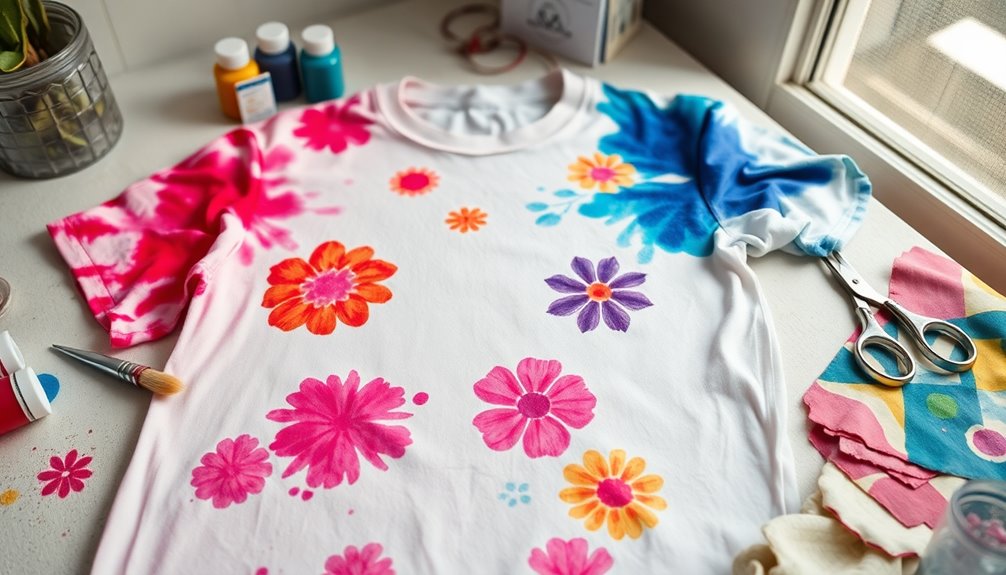
Upcycling your damaged garments can breathe new life into your wardrobe while showcasing your creativity. Instead of tossing out that bleach-stained shirt, think about how you can transform it. Techniques like tie-dyeing can turn those unsightly marks into vibrant patterns, giving your clothing a fresh look.
You can also use fabric paints to create artistic designs that incorporate the stains, making them part of a unique masterpiece.
If you're looking for a more straightforward fix, consider adding patches or appliqués. These not only cover up the stains but also serve as a fashionable statement, enhancing the overall aesthetic of your piece.
Additionally, you can repurpose stained items into home decor, like pillow covers or wall hangings, providing functional uses for damaged clothing while reducing waste.
Engaging in upcycling projects not only saves you money but also aligns with sustainable fashion practices that more consumers are embracing. By upcycling damaged garments, you contribute to a more eco-friendly approach to fashion, all while expressing your personal style.
Conclusion
Don't let a bleach stain dim the light of your favorite garment. With a little creativity and these DIY fixes, you can turn a mishap into a masterpiece. Whether you're dyeing, upcycling, or using natural remedies, you're not just salvaging fabric; you're breathing new life into your wardrobe. Remember, every flaw tells a story—embrace it, and let your clothes reflect the beautiful journey of their imperfections. Your style deserves a second chance!

